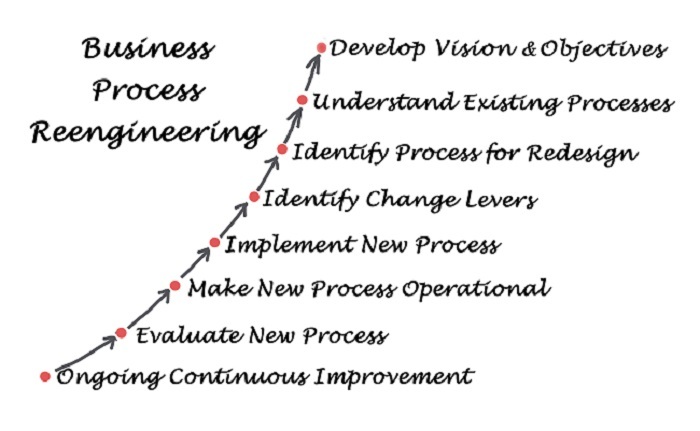
 Data Structure
Data Structure Networking
Networking RDBMS
RDBMS Operating System
Operating System Java
Java MS Excel
MS Excel iOS
iOS HTML
HTML CSS
CSS Android
Android Python
Python C Programming
C Programming C++
C++ C#
C# MongoDB
MongoDB MySQL
MySQL Javascript
Javascript PHP
PHP
- Selected Reading
- UPSC IAS Exams Notes
- Developer's Best Practices
- Questions and Answers
- Effective Resume Writing
- HR Interview Questions
- Computer Glossary
- Who is Who
Effect of Business Process Reengineering (BPR) in Operations
Introduction
Business Process Reengineering (BPR) is a management tool to radically redesign the existing operational process and structure as a whole in order to obtain a substantial increase in business outcome. Role of BPR mainly focuses on analysing the intra and inter-organizational work flows, eliminate tasks that do not enhance performance or customer value and optimize the entire business process.
Information technology is an integral part that caters to automation and networking linked processes that boost BPR initiatives. The result or effect of a BPR implementation would ideally result in trimming inefficient or replicated processes, bringing down costs and revamping the business resulting in high return on investment. The change of reengineering is reflected in the entire operations of the company and is discussed below.

Areas subject to change
The total overhauling, redesigning and revamping of BPR trigger changes to end to end business operations of an entity.
The four major areas that are subject to change after a BPR roll out are ?
Business Strategy
Organization
Technology
People.
Mapping the workflow to get a process view is primarily employed to observe these aspects.
Business Strategy
The business strategy serves as a master plan for all organizational activities. It gives a long-term perspective on the business objectives. It provides futuristic road maps, sets objectives and regulates tasks to leverage opportunities. Strategy builds a frame work for decision making and setting clear boundaries. Strategy being the pillar of operations, the prime change will be reflected here. All other facets revolve around the structure of a company's business strategy. Only a constructive change in strategy can cause its interlinked activities to advance accordingly. The interlinked tasks that add value to the customer shapes the business process. Strategies to manage process accountability, customer preferences, market trends and process functionalities need to be reassessed and redesigned.
Conventional strategies will have to rejected and redesigned with the insights gained through past experience.
For developing new models and initiating productive processes to be in place, an exhaustive updating of strategy is imperative.
The top management responsible for strategic decisions should exercise creativity and vision with motivation to accomplish a new kick start for the company.
A radical change to achieve a quantum jump in the business; being the motto of BPR, strategic decisions should be upgraded after in-depth identification and rigorous analysis.
All functional units of a business do its transition based on the strategic decisions taken.
Organization
BPR results in an overall organizational change. The reengineering process perceives business operations to be subdivided into tasks and processes that are accomplished by different functional units spread across the organization. BPR is hence an organizational event. It is not just confined to one or two functional units but spread across the entire entity. The reengineering efforts recognize the fact that only comprehensive performance of cross-functional departments can cater to the realisation of overall goals. BPR requires long term commitment of resources and meticulous effort throughout the organization.
Change is effected to each sub process to optimize the final result. A random manoeuvre or updation of existing process is not sufficient for attaining a dramatic boost in revenue. The process in place might be incompetent or out-dated to handle the current market conditions or customer expectations. BPR concentrates on redesigning the business process as a whole due to this fact. It is fully redesigning from the fundamentals of organization than at a mere functional level. It is through this way a radical change is effected to the organization. Achieving and succeeding dramatically in the advanced global market can be made possible only through such radical changes.
Technology
Technology can be viewed as the backbone of any reengineering activity. Information technology plays a pivotal role in gathering information for identification of possible problematic areas even before BPR is initiated. It does not mean simple automation of the existing processes, but finding new ways to speed up the process, reducing costs and delivering quality with the help of technology. Redundant processes, tasks duplications, time consuming hand-offs and extra man hours can be replaced effectively by integration of technology. Rapid innovation and advancement in IT field have made the market highly dynamic and tightly competitive.
Technology is considered as a vital enabler of business reengineering effort. A revolutionary change vital to adapt to and succeed in such a scenario undoubtedly require highly competent technology infrastructure. Information technology acts as a medium to upgrade the standard of operations as well as reducing many levels of process cycles.
Shared databases, image processing technologies, electronic data exchange and fund transfers, and easy access to required information make technology an integral part of BPR. It facilitated easy decision making and proper control by logically linking the business processes. Communication and networking systems help to centrally control all the functional units distributed geographically. Barriers of time and distance can be easily overcome through merging technology to business process that finally add value to the organization.
People
Human factor is finally the core element that decides the fate of any business process. Though the involvement of the top management is more obvious in the initiation of a reengineering activity, it is the people in an organization who need to take it forward. A change in the attitude, mind set and work culture of employees in an organization is an unavoidable effect of business process reengineering. The need and reasons for a redesigning effort need to be communicated to the people concerned prior to rolling out the BPR plan. They need to be convinced about the requirement and outcome of the entire exercise.
Cooperation and less resistance to change can be ensured if people are actively involved in the process of BPR.
Employee inputs regarding process delays, customer preferences, market trend and feedbacks could be sought before designing the new process.
Training and educating the ways and means to operate the redesigned processes will boost confidence and morale of the people involved.
Suppliers, customers and all other stake holders should also be brought into this change cycle by informing and capturing their inputs.
BPR may also pave way to lay-offs that make it a concern for the employees.
Early planning and control of the BPR team to tackle such people centric situations also warrant ample attention.
Conclusion
Reengineering in true sense does not limit its essence to refinement, but is rather a dramatic change. Almost all factors and process including organizational structure, management systems, performance indicators, job role and accountability, incentives, employee training, technology infrastructure and human resources are subject to change as an effect of BPR. Only such a drastic overhaul can result in a quantum leap in business outcomes.
Reengineering does have an impact on every aspect of an organization. Careful and systematic implementation of BPR can bring out enviable success by drastically reducing costs and time involved. It results in creating considerable optimization of business operations, adding customer value and achieving business objectives.

